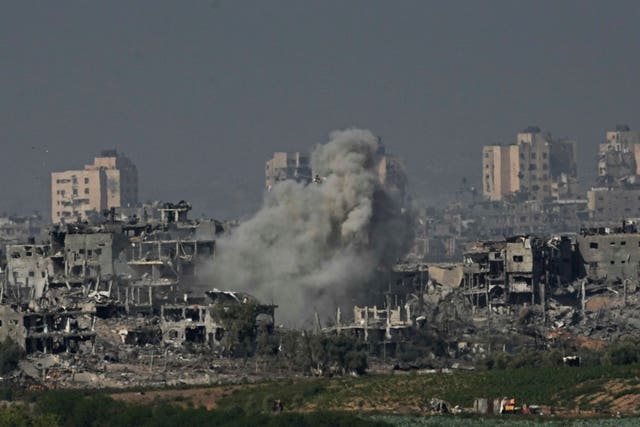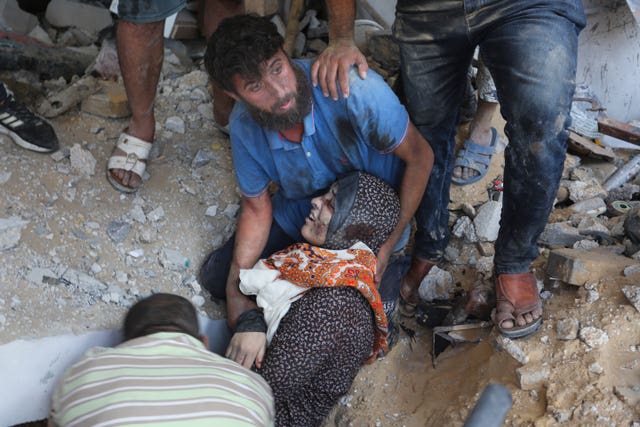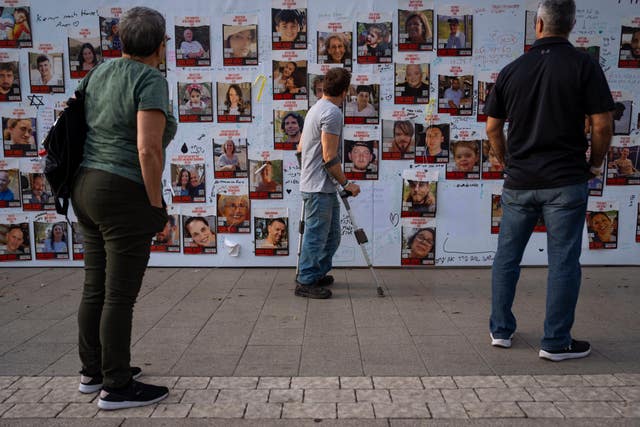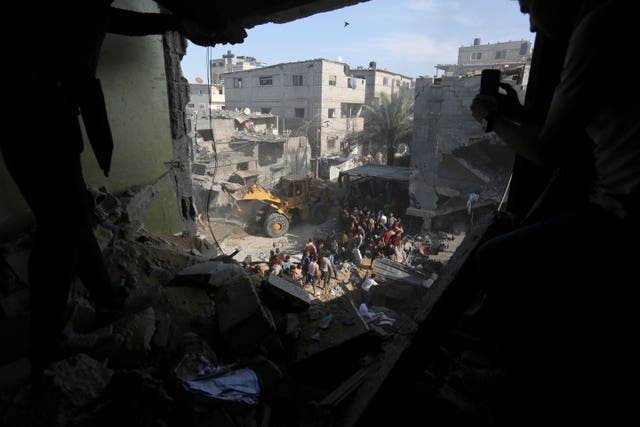Israeli ground forces attacked Hamas militants and infrastructure on Tuesday in northern Gaza as the military said about 800,000 people have fled the area since the war began more than three weeks ago.
Buoyed by the first successful rescue of a captive held by Hamas, Prime Minister Benjamin Netanyahu has rejected calls for a ceasefire and again vowed to crush the militant group’s ability to govern Gaza or threaten Israel following its bloody October 7 rampage, which ignited the war.
The military said one of the estimated 240 captives seized by Palestinian militants during the wide-ranging assault was rescued in a special forces operation, lending support to Mr Netanyahu’s contention that the ground war will help facilitate the recovery of more hostages rather than putting them in increased danger.

The army said Private Ori Megidish, 19, was “doing well” and had been reunited with her family.
Hamas has released four hostages, and has said it would let the others go in return for thousands of Palestinian prisoners held by Israel, which has dismissed the offer.
Hamas released a short video Monday showing three other female captives.

More than half the territory’s 2.3 million Palestinians have fled their homes, with hundreds of thousands sheltering in packed UN-run schools-turned-shelters or in hospitals alongside thousands of wounded patients. Israeli strikes have hit closer to several northern hospitals in recent days, alarming medics.
Jonathan Conricus, an Israeli military spokesman, said ground operations are focused on northern Gaza, including Gaza City, which he said was the “centre of gravity of Hamas”.
“But we also continue to strike in other parts of Gaza. We are hunting their commanders, we are attacking their infrastructure, and whenever there is an important target that is related to Hamas, we strike it,” he said.

Larger ground operations have been launched both north and east of Gaza City, which before the war was home to more than 650,000 people, a population comparable to that of Washington DC.
Video footage released by the military showed soldiers walking across an open area as heavy gunfire echoes in the background and setting up a position in the ruins of a heavily damaged building.
Conricus said some 800,000 people have heeded the Israeli military’s orders to flee from the northern part of the strip to the south.

But tens of thousands of people remain in and around Gaza City, and casualties are expected to mount on both sides as the battle moves into dense, residential neighbourhoods.
The military said it struck some 300 militant targets over the past day and that troops had engaged in several battles with Palestinian militants armed with antitank missiles and machine guns.
Hamas’ military wing said it fired mortar rounds at Israel forces near a closed border crossing between Israel and Gaza in the southern end of the territory. It was not possible to independently confirm the reports.
In a news conference late Monday, Netanyahu rejected calls for a ceasefire to facilitate the release of captives or end the war, which he has said will be long and difficult.

“Calls for a ceasefire are calls for Israel to surrender to Hamas,” he told a news conference. “That will not happen.”
Mr Netanyahu, who faces mounting anger over Israel’s failure to prevent the worst surprise attack on the country in a half century, also said he had no plans to resign.
Gaza’s humanitarian crisis is, meanwhile, continuing to worsen, with supplies of food, medicine, water and food running low because of a near-complete Israeli siege.
The UN agency for Palestinian refugees, known as UNRWA, says nearly 672,000 Palestinians are sheltering in its schools and other facilities, which have reached four times their capacity.
Thousands of people broke into its aid warehouses over the weekend to take food, in what it said was a sign of growing civil unrest.
UNRWA head Philippe Lazzarini accused Israel of “collective punishment” of the Palestinians, and of forcing their displacement from northern Gaza to the south, where they are still not safe.
The agency, which hundreds of thousands of people in Gaza rely on for basic services even in normal times, said 64 of its staff have been killed since the start of the war, including a man killed alongside his wife and eight children in a strike late on Monday.
“This is the highest number ever of UN aid workers killed in any conflict around the world in such a short time,” spokesperson Juliette Touma told the Associated Press. “UNRWA will never be the same without these colleagues.”
The death toll among Palestinians passed 8,300, mostly women and children, the Gaza health ministry said on Monday.
The figure is without precedent in decades of Israeli-Palestinian violence. More than 1.4 million people in Gaza have fled their homes.
Over 1,400 people have died on the Israeli side, mainly civilians killed during Hamas’ initial attack, also an unprecedented figure.




Why are you making commenting on The Herald only available to subscribers?
It should have been a safe space for informed debate, somewhere for readers to discuss issues around the biggest stories of the day, but all too often the below the line comments on most websites have become bogged down by off-topic discussions and abuse.
heraldscotland.com is tackling this problem by allowing only subscribers to comment.
We are doing this to improve the experience for our loyal readers and we believe it will reduce the ability of trolls and troublemakers, who occasionally find their way onto our site, to abuse our journalists and readers. We also hope it will help the comments section fulfil its promise as a part of Scotland's conversation with itself.
We are lucky at The Herald. We are read by an informed, educated readership who can add their knowledge and insights to our stories.
That is invaluable.
We are making the subscriber-only change to support our valued readers, who tell us they don't want the site cluttered up with irrelevant comments, untruths and abuse.
In the past, the journalist’s job was to collect and distribute information to the audience. Technology means that readers can shape a discussion. We look forward to hearing from you on heraldscotland.com
Comments & Moderation
Readers’ comments: You are personally liable for the content of any comments you upload to this website, so please act responsibly. We do not pre-moderate or monitor readers’ comments appearing on our websites, but we do post-moderate in response to complaints we receive or otherwise when a potential problem comes to our attention. You can make a complaint by using the ‘report this post’ link . We may then apply our discretion under the user terms to amend or delete comments.
Post moderation is undertaken full-time 9am-6pm on weekdays, and on a part-time basis outwith those hours.
Read the rules hereLast Updated:
Report this comment Cancel